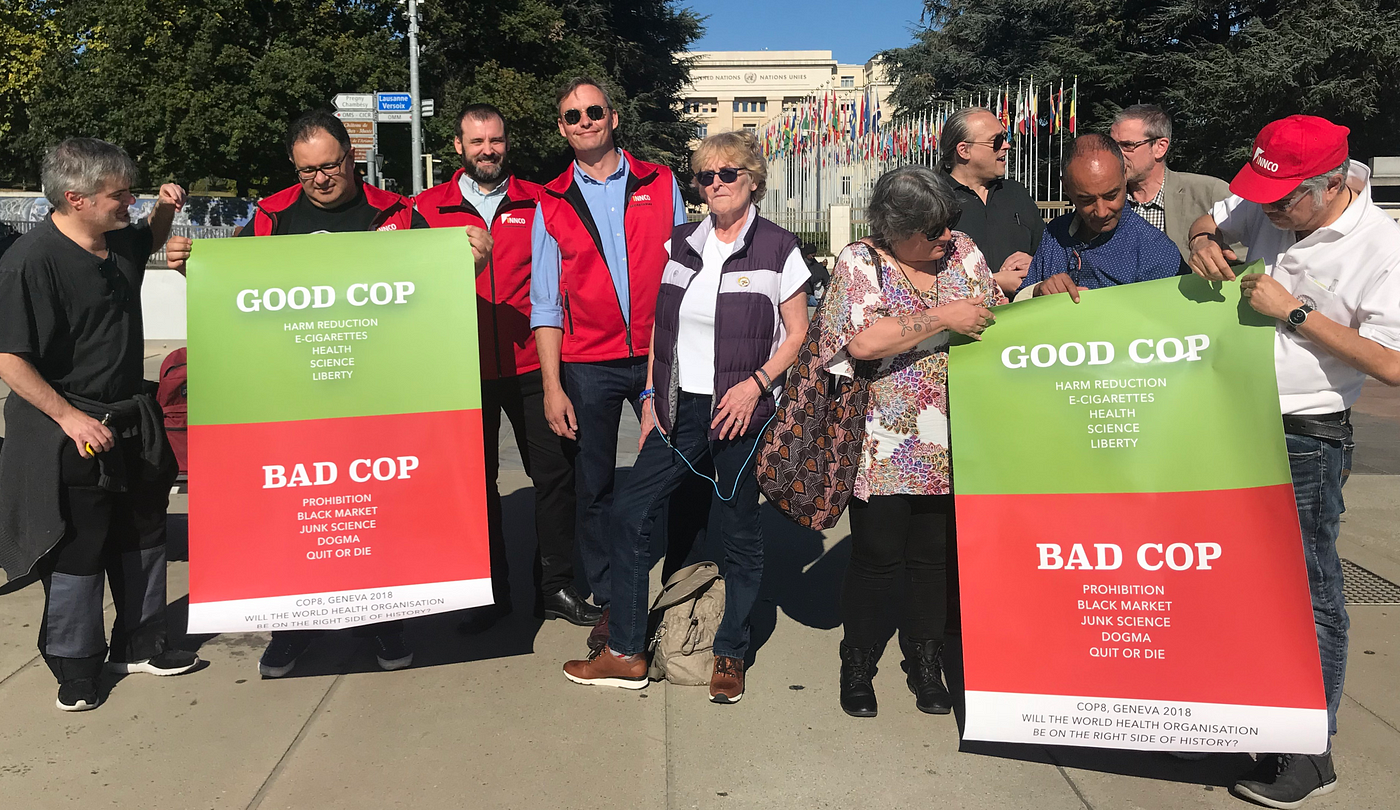Not a Fair COP

Nicotine users in Geneva during FCTC COP8 in 2018
Have you heard about COPs? Not the guys in uniforms, but “Conferences Of Parties (COPs).” Usually, it comes with a number, COP9, COP21, COP26… What does it mean? It’s pretty simple: each multilateral United Nations (UN) treaty is signed and/or ratified by some countries. When a country ratifies a UN treaty, it becomes “Party” to the treaty and gains a seat at COPs for that treaty. Each Party sends a delegation to the COP, which is the decision making body for that treaty.
There are many different COPs because there are many UN treaties (currently over 560). UN treaties cover many aspects of our everyday life, binding countries and other bodies to make international obligations.
The most well known COP is the United Nations Framework Convention on Climate Change (UNFCCC) COP. Each UNFCCC COP receives great media coverage. The next one, COP26, will be held in Glasgow in November 2021.
Many organizations and activists organize side events around all these COPS. There are open discussions around the world before UN COP meetings, as well as during and after these events. For example, the Inter-Parliamentary Union (IPU) has organised several meetings for the COP26.
These events are a great opportunity to openly exchange ideas and knowledge on how to best improve the treaty and its implementation around the world. Unfortunately, the official decisions made during the official UNFCCC COPs don’t always reflect the enthusiasms of all the activists and other stakeholders to save the planet. But, at least the discussions are open and the issues fully discussed.
In the UN ecosystem, there are many more obscure COPs. Some are held behind closed doors. One good example is the WHO Framework Convention on Tobacco Control (FCTC). The FCTC COP9 will be held in November this year, in The Hague, under this COP’s Islamic Republic of Iran presidency. Decisions taken at the FCTC COP9 will directly impact the health of 1.1 billion people around the world who smoke, 80% of whom live in Low and Middle Income Countries (LMICs).
FCTC COP9 will have no wide media coverage. There are no known inter-parliamentary group discussions. There is no open platform that promotes dialogue, awareness, education and commitment. The agenda, and even the names of the delegates, are kept secret. Both are heavily influenced by non-governmental organizations that are funded by large US foundations. No person impacted by their decisions has a voice.
How is it possible that the two COPs described above are so diametrically different? One listens to the voice of impacted people. The other turns a deliberate deaf ear. Ironically, both treaties are directly linked to the global UN Sustainable Development Goals (SDGs), whose mantra is: Leave no one behind.
The reason is that the FCTC has been funded and co-opted by wealthy US foundations that have an unrealistic solution for people who use nicotine: quit or die. UNFCCC COPs embrace innovation to mitigate climate change. But FCTC COPs reject innovation and the voices of anyone who suggests that safer nicotine alternatives to deadly combustible tobacco products could save millions of lives.
Over the past 20 years, since the FCTC treaty was signed, it has veered far beyond the original intent of the signatories. They refuse new strategies to prevent tobacco-related death and disease, including Tobacco Harm Reduction (THR), despite the fact that the FCTC treaty’s Art. 1 explicitly defines “tobacco control” as including harm reduction.
It’s time for a fundamental change. Traditional tobacco control strategies have so far succeeded in reducing smoking rates, but primarily only in high-income countries. We — people who use safer nicotine — want FCTC COPs to be more open, more democratic, more science-driven, more respectful of our human rights… as most other UN COPs are.
We are not alone. In the UK, an All-Party Parliamentary Group recently published a report which is highly critical on FCTC COPs and the WHO’s steadfast THR-denialist position. The UK is a global leader in tobacco control and THR with one of the lowest smoking rates in the world. The UK now wants to do even better, but is feeling hamstrung by the FCTC’s current dogmatic position.
We, at INNCO, ask citizens around the world who believe that respectful open-minded multilateral dialogue is the only way to solve issues, to carefully and critically review the work produced by the FCTC COPs and the WHO, especially with regard to THR. Question your government. Question your parliament. Ask what your country’s position will be at COP9. Use freedom of information and transparency laws if necessary, and if possible.
We call, once again, on the FCTC Secretariat to listen to the voices of consumers, and especially ex-smokers like us who use safer nicotine alternatives to quit or reduce exposure to toxic forms of tobacco. These are basic human rights and social justice issues: We deserve a seat at the table in all discussions of policies that affect us.
We also ask the media around the world to cover FCTC COPs just as they would for other UN COPs, to better inform the public. We ask parliament groups around the world to be inspired by the UK parliament group and to question their own government’s position.
Finally, we specifically call upon parliament groups to collaborate through the IPU, and/or other informal meetings, as they do for other UN COPs, in order to ensure that future FCTC COPs are an open place for dialogue with all stakeholders, including most importantly: “people who use safer nicotine to quit toxic forms of tobacco.”
Nothing about us without us!
#FCTC #COP9 #UNFCCC #COP26 #IPU #UK
____________________________________________
INNCO is funded by hundreds of individual adults who use safer nicotine and by the Foundation for a Smoke-Free World. The Foundation is a US nonprofit 501(c)(3) private foundation with a mission to end smoking in this generation. Under the Foundation’s Bylaws and Pledge Agreement with its funder, the Foundation is independent from that funder. Details are available on the Foundation’s website (www.smokefreeworld.org). INNCO is independent of (and was established before) the Foundation. Our mission, purpose and goals are driven by our Member Organizations in 35 countries around the world. INNCO members are unpaid volunteers: ex-smokers who, as a condition of membership, agree not to accept funding or direction from any tobacco firm. The contents of this article are the sole opinion and responsibility of INNCO, and under no circumstances shall be regarded as reflecting the positions of the Foundation or any other entity.





